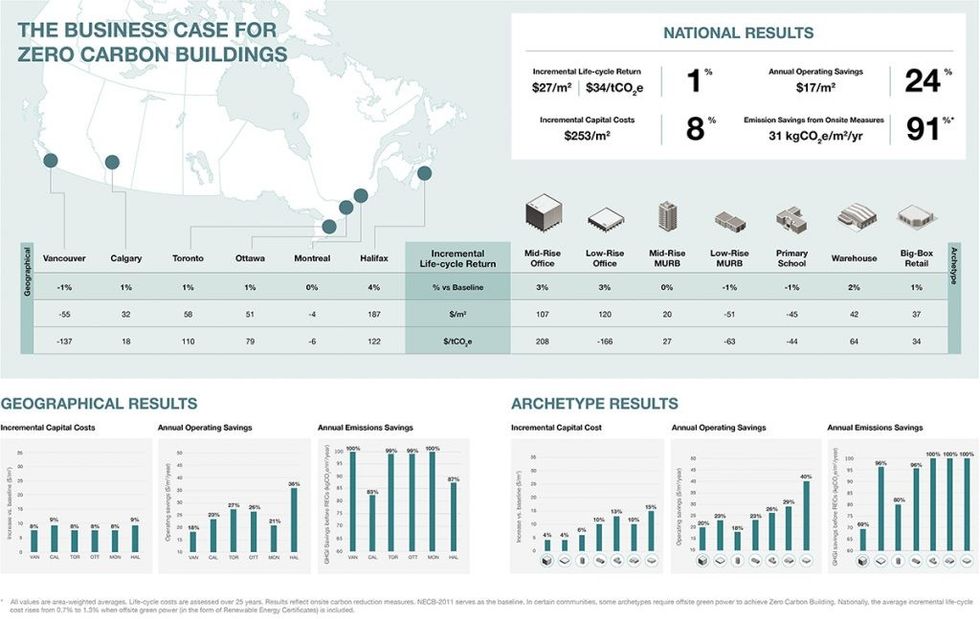It’s official — zero carbon buildings are the buildings of the future.
A study conducted by the Canada Green Building Council (CaGBC) found that these types of structures aren’t just eco-friendly, They're also good financial investments.
READ: 14 Little Changes To Save You Money And Make Your Home More Eco-Friendly
“On average, ZCBs can be achieved with a positive financial return of one per cent over a 25-year life-cycle, inclusive of carbon pollution pricing, and require a modest eight per cent capital cost premium,” the report concluded. “As the cost of carbon rises over time, the financial return from ZCBs will improve.”
In the report, carbon reduction measures were applied to seven building types — low-rise and mid-rise office, low-rise and mid-rise multi-unit residential, primary school, big box retail, and warehouse — in six Canadian cities.

Overall, zero carbon buildings were found to be financially viable in all cities — Toronto, Ottawa, Montreal, Vancouver, Calgary, and Halifax — despite differences in construction costs, climate, and other factors.
Halifax had the highest return over a 25-year life-cycle, with an average of four per cent. The city’s low cost of electricity and the high-carbon intensity of the Nova Scotia electricity grid both influenced the high returns, according to the study.
READ: 7 Things You’ll Need To Ditch If The Ontario Gov’t Bans Single-Use Plastic
Toronto, Ottawa, Calgary, and Montreal saw their upfront capital costs diminished over a 25-year period. The former three cities experienced a return of one per cent, while Montreal just broke even.
Vancouver is the only city that just barely reached the break-even mark. This is a result of the low-carbon intensity of the electricity grid and the low cost of natural gas, the report noted.
READ: Torontonians Might Be Charged Extra Fees On Coffee Cups In The Future
Zero carbon buildings not only offer financial benefits to builders and property owners but to tenants as well, Canadian Architect reports. They are more energy efficient, help reduce carbon pollution, and avoid the need for costly retrofits in the future.
Specifically, in the long run, zero carbon buildings can also help reduce greenhouse gases, which is an issue Canada has been trying to tackle. The country made a commitment to reduce emissions by 30 per cent below 2005 levels by 2030, and in 2018, it was projected that they would be able to hit that target and reduce levels further by up to four per cent.
READ: 8 Toronto Neighbourhoods Nature Lovers Won’t Be Able To Resist
Investing in zero carbon buildings can help Canada accelerate this process. According to the study, an incremental capital cost of $3.3 billion per year can result in roughly 47,500 new residential units and 4,800 commercial zero carbon buildings annually to help further reduce greenhouse gases.
“This study shows us definitively that Zero Carbon Buildings can be achieved with existing market-ready technologies and approaches for most building types, and that operating cost savings will cover the needed investments,” Thomas Mueller, President and CEO at CaGBC, said in a statement. “The Canadian building industry and governments now have proof to make the changes needed to create Canada's low carbon building stock and avoid creating buildings that will become a liability in a carbon-constrained economy.”
A rendering of Waterloo's evolv1
CaGBC started a zero carbon building initiative in 2017 and now have 16 projects across Canada. Only three buildings, however, are certified as meeting Zero Carbon Building Standard: Waterloo’s evolv1, Hamilton’s Mohawk College, and Saint-Eustache, Que.’s École Curé-Paquin.





















